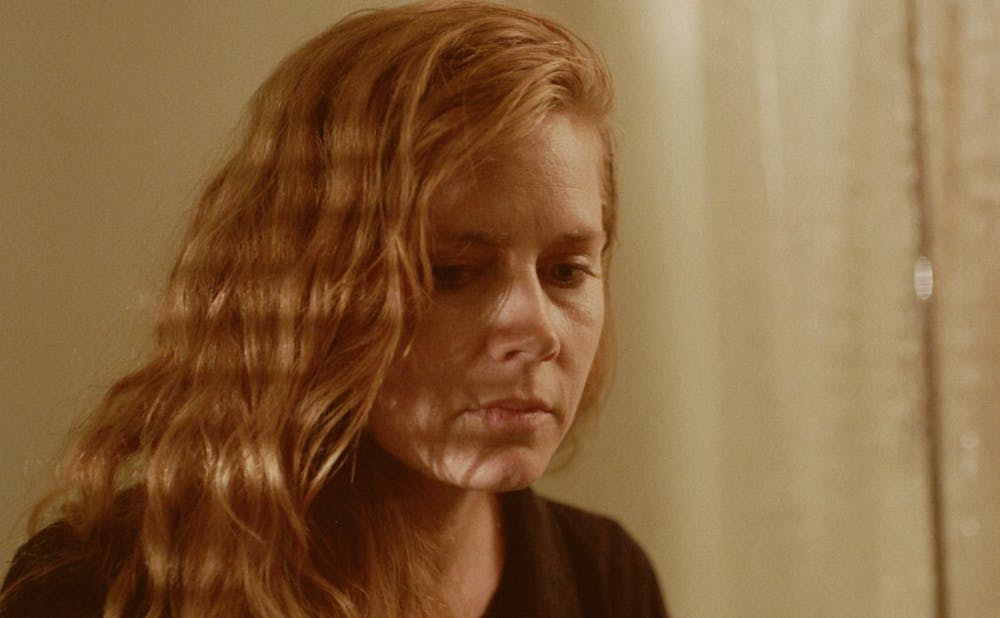Everything about the small town of Wind Gap, Missouri — the fictional setting of the book-turned-miniseries “Sharp Objects” — looks like it’s been lifted out of a Flannery O’Connor story: antebellum homes as white as cotton that rest on carefully manicured lawns, industrial pig farms that reek of generational wealth, a bucolic downtown dotted with mom-and-pop stores and friendly faces. Missouri is solidly Midwestern in its geography, yes, but its history is mired in Southern tradition and pride, relics of the state’s patronage to the Confederacy. And, like its southern counterparts, Wind Gap is quietly eerie, abandoned both physically and spiritually, a haunting reminder of the past and all its skeletons.
Adapted from Gillian Flynn’s debut novel of the same name, “Sharp Objects” seemingly tells the story of crime reporter Camille Preaker (played by Amy Adams), who returns to her hometown of Wind Gap to investigate the recent murders of two young girls. But the eight-episode miniseries, directed by Jean-Marc Vallée (of “Big Little Lies” fame), pushes the excitement of the “whodunit” mystery to the wayside, using it as a backdrop to a far more complex interrogation of character and place. As soon as Camille sets foot in Wind Gap, her demons swarm her — alcoholism, a need to self-harm, memories of her dead sister, a socialite mother who’s emotionally unavailable — and it becomes apparent that whatever’s going on in her head is far more interesting than the murder mystery at play.
Similar to Vallée’s “Big Little Lies” and Flynn’s “Gone Girl,” “Sharp Objects” is particularly interested in women — how they interact with their surroundings, their relationships with other women, their complexities and atrocities. Camille’s interactions with her mother, Adora (Patricia Clarkson), are melodramatic and borderline unbearable: “I never loved you. I hope that can be a comfort to you,” Adora tells Camille over drinks, the repulsion in her voice unmistakable. Adora acts horribly villainous, but she’s tender at times, too, swaying to 2Pac’s “Dear Mama” while Amma (Eliza Scanlen), her daughter and Camille’s half-sister, holds her. Alan (Henry Czerny), Adora’s husband and Camille’s step-father, reminds Camille that Adora’s mother was vicious to her as a child, claiming she’d sneak into Adora’s room at night just to pinch her while she slept. It’s not an excuse, but it’s an explanation: Trauma is generational, a shared familial bond in the nastiest sense, and Adora is deeply spiteful of Camille’s rejection of such tradition.
Most fascinating is Camille’s relationship with her estranged, teenaged half-sister Amma. While Camille outwardly rejects her mother’s debutante lifestyle, Amma plays along — at least, while Adora is watching. She’s prim and well-mannered in front of her mother and a drug-using, booze-drinking wild child behind her back, darting between sweet and sour like it’s nothing, manipulating those around her to her immediate benefit. Amma and Camille are a confused, oddly-situated pairing: They’re not quite sisters but not quite strangers, estranged but proximate because of their shared experiences; at times, their relationship plays like that of a parent and a child, and at others, they’re borderline incestuous. But, undoubtedly, Amma is always in control, carefully pulling the strings — despite their supposed domesticity, in Wind Gap, women are far more powerful than men.
In a moment of vulnerability, Camille tells her editor, “I feel like a bad person.” He reassures her that she’s as decent as they come, and as she cries, we’re inclined to agree. But is she decent? Or, more specifically, why should we dislike her if she actually is bad? Maybe she’s no better than Amma or Adora — she can be callous and manipulative when she wants to be — but Flynn seems uninterested in making morality judgements. Who decides what makes us good or bad, anyway, and why is there such pressure to be good? In Wind Gap, no one’s closet is free of skeletons. Plus, there’s something particularly splendid about female characters who are remorselessly evil. Who says we’re not allowed to be irredeemable?
“Sharp Objects” is a slow burn, winding up for an explosive finish as the tension ratchets upward with each passing episode. The cinematography is soft and fuzzy, and sometimes you can’t tell if what you’re watching is a dream or reality; words and images pop, almost subliminally, in and out of frames without notice. The transitions between present-time and flashbacks are hazy and seamless, and sometimes the past intrudes upon the present, eroding Camille’s sense of time and place. Perhaps that’s because those things don’t really exist — Camille’s memories of Wind Gap are inextricable from her understanding of herself, and she can never fully escape them, no matter how far away she moves or how old she grows.
When the explosion comes, it will undoubtedly be a tragic and harrowing display that will knock Wind Gap off its feet. But that won’t be the highlight of “Sharp Objects.” No, the true beauty of the series comes from its grotesque but damning portrayal of familial relationships, the way it warps and twists concepts like love and truth and morality, its nerve in portraying truly nasty women and men. Its ugliness, bold and unafraid. The rest is inessential.
Get The Chronicle straight to your inbox
Signup for our weekly newsletter. Cancel at any time.

